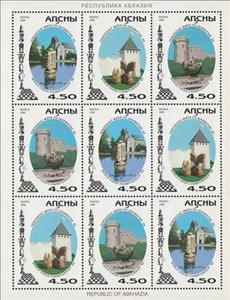Mini Sheet: Ancient Russian and Scandinavian Chessmen (Abkhazia 1999)
Ancient Russian and Scandinavian Chessmen (Abkhazia 1999)
04 March (Abkhazia ) within release World Chess Championship '99 goes into circulation Mini Sheet Ancient Russian and Scandinavian Chessmen face value 9*4.50 Russian ruble
| Mini Sheet Ancient Russian and Scandinavian Chessmen in catalogues | |
|---|---|
| Michel: | Mi: AB 340-342KB |
Mini Sheet is vertical format.
Exists imperforated. Stamp number in Catalog of Republic of Abkhazia: MS.377-379Also in the issue World Chess Championship '99:
- Mini Sheet - Ancient Russian and Scandinavian Chessmen face value 9*1.50;
- Mini Sheet - Ancient Russian and Scandinavian Chessmen face value 9*4.50;
- Mini Sheet - Ancient Russian and Scandinavian Chessmen face value 9*5;
- Stamp - Bishop and Pawn, VII-VIII century face value 5;
- Stamp - King and Pawn, XII century (Isle of Lewis, Sweden) face value 5;
- Stamp - King and Queen, VII century (Lukoml and Slutsk, Belarus) face value 5;
- Stamp - King and Queen, XII century face value 5;
- Stamp - King and Rook, X-XII century (Nurnberg, Germany) face value 5;
- Stamp - Rook, XII century (Volkovysk, Belarus) face value 5;
- Stamp - Rook, XIII century face value 5;
- Stamp - Rook, XIV-XV century (Novgorod, Russia) face value 5;
- Stamp - Rook, XIV-XV century (Trakai, Lithuania) face value 5;
Mini Sheet Ancient Russian and Scandinavian Chessmen it reflects the thematic directions:
Chess is usually played by two players (called chess players) against each other. It is also possible for one group of chess players to play against another or against one player; such games are often called consultation games. In addition, there is the practice of simultaneous play sessions, when several opponents play against one strong player, each on a separate board.
The rules of the game were basically developed by the 15th century; In modern official tournaments, the rules of the International Chess Federation[6] are applied, which regulate not only the movement of pieces, but also the rights of the judge, the rules of behavior of players and time control. A game played remotely - for example, by correspondence, by telephone or via the Internet - has special rules. There are many variants of chess that differ from classical ones: with non-standard rules, pieces, board sizes, etc. The corresponding section of chess composition is fairy chess. Some aspects of the game of chess are studied in mathematics (for example, the classic “Knight's Move Problem” and “Eight Queens Problem”), including through computer simulation. Chess is usually played by two players (called chess players) against each other. It is also possible for one group of chess players to play against another or against one player; such games are often called consultation games. In addition, there is the practice of simultaneous play sessions, when several opponents play against one strong player, each on a separate board.
The rules of the game were basically developed by the 15th century; In modern official tournaments, the rules of the International Chess Federation[6] are applied, which regulate not only the movement of pieces, but also the rights of the judge, the rules of behavior of players and time control. A game played remotely - for example, by correspondence, by telephone or via the Internet - has special rules. There are many variants of chess that differ from classical ones: with non-standard rules, pieces, board sizes, etc. The corresponding section of chess composition is fairy chess. Some aspects of the game of chess are studied in mathematics (for example, the classic “Knight's Move Problem” and “Eight Queens Problem”), including through computer simulation.
The horse (Equus ferus caballus) is one of two extant subspecies of Equus ferus. It is an odd-toed ungulate mammal belonging to the taxonomic family Equidae. The horse has evolved over the past 45 to 55 million years from a small multi-toed creature, Eohippus, into the large, single-toed animal of today. Humans began to domesticate horses around 4000 BC, and their domestication is believed to have been widespread by 3000 BC. Horses in the subspecies caballus are domesticated, although some domesticated populations live in the wild as feral horses. These feral populations are not true wild horses, as this term is used to describe horses that have never been domesticated, such as the endangered Przewalski's horse, a separate subspecies, and the only remaining true wild horse. There is an extensive, specialized vocabulary used to describe equine-related concepts, covering everything from anatomy to life stages, size, colors, markings, breeds, locomotion, and behavior.


